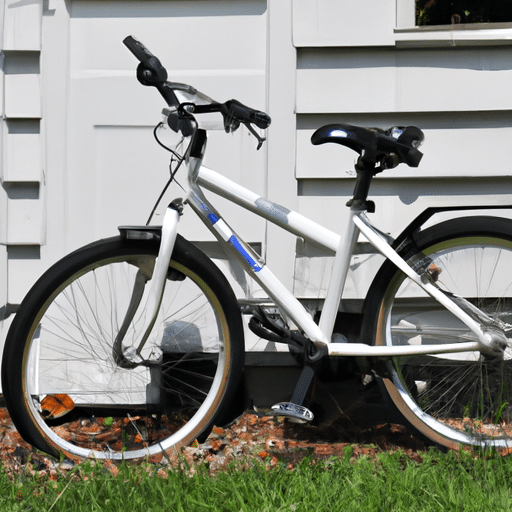Are you considering taking up cycling but unsure if a cruiser bike is the right choice for you? This article explores whether a cruiser bike can provide you with a great workout and help you achieve your fitness goals.
Join us as we uncover the benefits of cruising along on a stylish and comfortable cruiser bike and discover how it can contribute to a fun and effective exercise routine.
Whether you’re a leisurely rider looking to enjoy the scenery or a fitness enthusiast seeking a low-impact workout, we’ve got all the answers to decide if a cruiser bike is the perfect fit for your fitness journey.
Table of Contents
The Benefits of Exercise
Exercise is a crucial aspect of maintaining a healthy lifestyle, and there are numerous benefits to incorporating regular physical activity into our daily routines. In this article, we will explore the many advantages of exercise, mainly focusing on the benefits of cruiser biking. From improving cardiovascular health to enhancing mood and mental well-being, exercise has the power to transform our lives.
Improves Cardiovascular Health
One of the most significant benefits of exercise is its positive impact on cardiovascular health. Regular aerobic exercise, such as cruiser biking, can help strengthen the heart and improve blood circulation. As we pedal our way along scenic routes on our cruiser bikes, our heart rate increases, contributing to a more efficient cardiovascular system. This, in turn, lowers the risk of developing heart disease, high blood pressure, and other cardiovascular conditions.
Weight Management
Maintaining a healthy weight is crucial for overall well-being, and exercise is critical in weight management. Cruiser biking can be an effective form of exercise for those looking to shed unwanted pounds or maintain a healthy weight. It offers a full-body workout that engages multiple muscle groups, helping to burn calories and increase metabolism. By incorporating regular cruiser bike rides into our fitness routine, we can maintain a healthy weight while enjoying the great outdoors.
Boosts Mood and Mental Well-being
Exercise can remarkably boost our mood and enhance our mental well-being. When we engage in physical activity, our brain releases endorphins, which are often referred to as “feel-good” hormones. These endorphins help alleviate stress, reduce anxiety, and combat symptoms of depression. Cruiser biking, with its leisurely pace and enjoyable scenery, provides an excellent opportunity to unwind, clear our minds, and experience an uplifted mood. Combining fresh air, physical exertion, and pleasant surroundings can work wonders for our mental health.
Understanding Cruiser Bikes
Now that we understand exercise’s benefits let’s delve into the specifics of cruiser bikes. Cruiser bikes, also known as beach cruisers, are famous for leisurely rides and comfortable cycling experiences. They are renowned for their timeless design, comfortable seating position, and easy-to-ride nature. Whether we are looking for a laid-back ride along the beach or a relaxing trip around the neighborhood, cruiser bikes offer a unique cycling experience.
Overview of Cruiser Bikes
Cruiser bikes are designed with a simple yet classic design emphasizing comfort and ease of use. They typically feature a single-speed or multi-speed drivetrain, wide handlebars, a broad and cushioned saddle, and large balloon tires. The frame of a cruiser bike is often constructed from durable steel, ensuring stability and longevity. These bikes are known for their smooth and relaxed ride, making them popular for individuals of all ages and fitness levels.
Features and Design
The design of cruiser bikes sets them apart from other types of bicycles. They typically have a curved and elongated frame, with the top tube sloping downward towards the seat. The wide handlebars provide improved steering control and a more relaxed riding position. Additionally, cruiser bikes often come with features such as a front basket or rear rack for carrying personal items or groceries, further adding to their practicality and convenience.
Suitability for Leisure and Comfort
If we are looking for a bike that prioritizes leisure and comfort, cruiser bikes are an excellent choice. The wide, padded saddle and ergonomic riding position promote a relaxed and enjoyable ride, perfect for cruising along scenic routes or exploring our local neighborhoods. The larger, cushioned cruiser bike tires provide a smooth and stable ride, absorbing bumps and uneven terrain. Whether planning a leisurely ride with friends or seeking a comfortable cycling option, cruiser bikes are a fantastic choice for a relaxed and enjoyable experience.
Physical Activity Level
Now that we understand cruiser bikes well let’s explore their impact on our physical activity level. Understanding how cruiser biking affects our heart rate and engages different muscle groups can help us tailor our exercise routine to meet our fitness goals.
Cruiser Bikes and Intensity of Exercise
Cruiser biking is generally considered a low-intensity form of exercise. The leisurely pace and relaxed nature of cruiser bikes make them ideal for individuals seeking a milder workout or those new to cycling. While cruiser bikes may not have the same intensity as higher-performance biking options, they offer various physical benefits. Regular cruiser biking can help improve stamina and endurance, making it an excellent choice for those looking to increase their fitness level gradually.
Impact on Heart Rate
The intensity of exercise is often closely linked to our heart rate. While cruiser biking may not elevate our heart rate to the same extent as more intense forms of exercise, it can still provide a cardiovascular workout. The rhythmic pedaling involved in cruiser biking helps elevate our heart rate to a moderate level, providing a beneficial workout for our cardiovascular system. By consistently engaging in cruiser biking, we can gradually improve our cardiovascular fitness and overall heart health.
Comparison to Other Types of Bikes
When considering the physical activity level of cruiser biking, it is essential to compare it to other types of bikes. Cruiser bikes generally require less effort and exertion than road bikes or mountain bikes, designed for more intense riding. However, cruiser bikes can still provide a satisfying workout, particularly for individuals who prefer a more relaxed and less demanding cycling experience. Selecting a bike that aligns with our fitness goals and personal preferences is crucial, allowing us to enjoy the exercise at our own pace.
Muscle Engagement
While cruiser biking is known for its leisurely and comfortable ride, it still engages various muscle groups, providing a beneficial workout for our bodies. Let’s explore the specific muscles that are worked while riding a cruiser bike.
Muscles Worked While Riding a Cruiser Bike
Cruiser biking primarily targets the lower body muscles, including the quadriceps, hamstrings, glutes, and calves. These muscles are crucial in pedaling and generating the necessary power to move the bike forward. By pedaling in a circular motion and powering each stroke, we engage these lower body muscles, helping to increase their strength and endurance. Additionally, the core and hips muscles contribute to the stability and balance required while riding a cruiser bike.
Lower Body Muscle Activation
Riding a cruiser bike requires continuous leg movement, which directly engages the lower body muscles. The quadriceps in the front of the thighs extend the knee during the downward pedal stroke. The hamstrings at the back of the thighs play a vital role in flexing the knee during the upward stroke. The glutes, or the muscles of the buttocks, provide power and stability during the pedaling motion. Finally, the calf muscles work to provide additional power, particularly during the downward portion of the pedal stroke.
Limited Upper Body Involvement
While cruiser biking does engage some upper body muscles, such as those in the arms and shoulders, the involvement is generally limited compared to other forms of exercise or bike riding. The primary focus remains on the lower body muscles, which generate the power to move the bike forward. However, maintaining an upright posture and keeping a firm grip on the handlebars engage the upper body muscles to a certain extent, contributing to overall stability and control.
Calorie Burn
Calorie burn is a significant consideration for many individuals when deciding on an exercise routine. Let’s explore the factors that affect calorie burn on a cruiser bike and compare it to other forms of exercise.
Factors Affecting Calorie Burn on a Cruiser Bike
The number of calories burned during a cruiser bike ride depends on various factors, including body weight, ride intensity, duration, and terrain. Heavier individuals tend to burn more calories while cycling due to the increased effort required to move the bike.
Intensity, influenced by speed and resistance, also affects calorie burn. Challenging terrains, such as hilly areas, can further increase calorie expenditure during a cruiser bike ride.
Comparison to Other Forms of Exercise
Cruiser biking may not be as intense as running or high-intensity interval training (HIIT) when comparing calorie burn. However, it can still provide a moderate calorie burn, particularly when considering longer rides or hilly terrains.
The leisurely pace of cruiser biking makes it a sustainable form of exercise, allowing individuals to engage in more extended sessions and potentially burn many calories. It may be especially suitable for individuals who prefer low-impact exercises or those recovering from specific injuries.
Tips to Increase Calorie Burn
For individuals looking to maximize calorie burn during cruiser biking, there are several tips to consider. Increasing the intensity of the ride by incorporating intervals of higher speed or resistance can help elevate heart rate and calorie expenditure.
Opting for longer rides or exploring more challenging terrains can increase calorie burn. Maintaining proper form and technique while pedaling can also ensure optimal muscle engagement and energy expenditure.
Joint Impact and Safety
Considering the impact on our joints and prioritizing safety is crucial when engaging in any exercise. Cruiser biking offers numerous benefits in terms of joint impact and overall safety.
Low Impact Exercise
Cruiser biking is considered a low-impact exercise, which places minimal stress on the joints. The comfortable seating position, padded saddle, and larger balloon tires of cruiser bikes help absorb the shocks and vibrations caused by uneven terrain. This makes cruiser biking an excellent choice for individuals with joint-related conditions or those who prefer a gentler exercise. The low-impact nature of cruiser biking reduces the risk of joint injuries and allows individuals to engage in regular physical activity without discomfort.
Reduced Strain on Joints
Compared to high-impact activities such as running or high-intensity workouts, cruiser biking places considerably less strain on the joints. A cruiser bike’s smooth and relaxed ride ensures that the impact forces are distributed evenly throughout the body, reducing the risk of joint pain or injury. This makes it an ideal choice for individuals of all ages and fitness levels, allowing them to exercise regularly without worrying about undue stress on their joints.
Promoting Safety While Riding
Safety is paramount when exercising, and cruiser biking is no exception. To ensure a safe and enjoyable ride, it is essential to follow a few guidelines. Wearing a helmet is crucial to protect against head injuries in accidents or falls. Additionally, wearing reflective clothing and using lights on our bikes can significantly enhance visibility, especially when riding in low-light conditions. Obeying traffic rules, signaling turns, and maintaining a safe distance from other cyclists or pedestrians are also crucial for ensuring a safe cruising experience.
Factors Influencing Exercise Intensity
The intensity of an exercise session can significantly impact the benefits gained from the activity. Let’s explore the factors that influence the exercise intensity of cruiser biking.
Pace and Duration of Rides
The pace and duration of our cruiser bike rides play a significant role in determining the exercise intensity. Increasing the speed or maintaining a faster pace can elevate our heart rate and increase calorie burn. Similarly, longer rides require more sustained effort, leading to higher cardiovascular exertion. By gradually increasing the speed or duration of our cruiser bike rides, we can challenge ourselves and achieve a more intense workout.
Incorporating Inclines or Resistance
To increase the intensity of cruiser biking, incorporating inclines or resistance can provide an additional challenge. Riding uphill or against resistance, such as a headwind, requires more effort and engages additional muscle groups. These added challenges increase the overall intensity of the workout, leading to enhanced fitness benefits. By seeking out routes with varying terrain or using bikes with multiple gears, we can customize our rides to suit our desired intensity level.
Cycling Form and Technique
Proper cycling form and technique can significantly impact exercise intensity and muscle engagement during cruiser biking. Maintaining an upright posture and pedaling with a smooth, circular motion ensures optimal muscle activation and energy expenditure. Focusing on pushing and pulling with each leg during the pedal stroke helps engage the quadriceps, hamstrings, and calf muscles more effectively. We can maximize the benefits gained from our cruiser bike rides by paying attention to our cycling form and technique.
Considerations for Beginners
If we are new to cruiser biking or exercise, we must consider a few factors before embarking on our fitness journey. Gradually easing into the exercise routine and monitoring our exertion levels are crucial for beginners.
Starting at a Comfortable Pace
For individuals new to cruiser biking, starting at a comfortable pace is essential. Begin with shorter rides at a leisurely pace, allowing your body to adjust to the physical demands of cycling. As your fitness level improves, gradually increase the duration and intensity of your rides. This gradual approach will prevent excessive muscle soreness and reduce the risk of overexertion.
Gradually Increasing Intensity
As we become more comfortable with cruiser biking, gradually increasing our ride intensity is crucial. This can be achieved by incorporating higher speed or resistance intervals, riding longer distances, or tackling more challenging terrains. However, we must listen to our bodies and avoid pushing ourselves beyond our limits. Incremental increases in intensity allow our bodies to adapt to the demands of the exercise, leading to steady progress and improved fitness.
Monitoring Exertion Levels
Monitoring our exertion levels during cruiser biking is essential to ensure we are exercising at an appropriate intensity. One effective method for gauging exertion is using the Borg Rating of Perceived Exertion (RPE) scale. This scale rates perceived exertion on a scale of 6 to 20, with six corresponding to negligible exertion and 20 indicating maximum effort. Beginners should aim for an RPE of around 12 to 14 during their cruiser bike rides, corresponding to a moderately challenging intensity.
Cruiser Biking for Specific Goals
Cruiser biking can be tailored to meet specific fitness goals, including weight loss, strength and endurance training, and low-intensity exercise for recovery. Let’s explore how cruiser biking can be adapted to achieve these goals.
Weight Loss and Calorie Management
Cruiser biking can be an effective tool for weight loss and calorie management. By consistently engaging in cruiser bike rides and maintaining a balanced diet, individuals can create a calorie deficit, leading to gradual weight loss. To optimize weight loss, gradually increasing the intensity and duration of cruiser bike rides is essential. Incorporating healthy eating habits and monitoring calorie intake can further support weight management efforts.
Strength and Endurance Training
While cruiser biking is generally considered a low-intensity exercise, it can still contribute to strength and endurance training. By incorporating increased speed or resistance intervals, individuals can challenge their muscles and cardiovascular system, improving strength and endurance. Longer rides and tackling challenging terrains can enhance muscular and cardiovascular fitness. Regular cruiser biking can help build lower body strength and improve cardiovascular endurance.
Low-Intensity Exercise for Recovery
Cruiser biking can also serve as a valuable low-intensity exercise for recovery. After engaging in high-intensity workouts or strenuous activities, a gentle cruiser bike ride can help promote active recovery. The low-impact nature of cruiser biking ensures minimal stress on joints, allowing individuals to engage in physical activity without overtaxing their bodies. The leisurely pace and relaxing nature of cruiser biking can provide a much-needed break for the muscles while still promoting blood circulation and mobility.
Supplementing Cruiser Bike Exercise
While cruiser biking offers numerous benefits, incorporating additional forms of exercise can enhance our overall fitness and well-being. Let’s explore some ways to supplement cruiser bike exercise.
Incorporating Strength Training
To complement cruiser biking, incorporating strength training exercises can be highly beneficial. Strength training helps build muscle mass, increase bone density, and improve overall functional strength. Individuals can target specific muscle groups not extensively worked during cruiser biking by engaging in exercises such as bodyweight, weightlifting, or resistance training. This balanced approach to exercise promotes overall fitness and helps prevent muscle imbalances.
Additional Cardio Exercises
While cruiser biking provides a cardiovascular workout, incorporating additional cardio exercises can enhance cardiovascular fitness. Activities such as running, swimming, or aerobic classes can provide a more vigorous cardiovascular challenge and help improve endurance. By alternating between different forms of cardio exercises, individuals can add variety to their fitness routine and maximize cardiovascular benefits.
Balancing with Flexibility and Mobility Work
In addition to cardio and strength training, it is essential to include flexibility and mobility work in our exercise routine. Stretching exercises, yoga, or Pilates can help improve flexibility, joint mobility, and posture.
These exercises complement the muscle engagement and joint impact of cruiser biking, promoting overall body harmony and reducing the risk of muscle tightness or imbalances. By incorporating regular flexibility and mobility work, individuals can enhance their overall range of motion and protect against injuries.
In conclusion, cruiser biking offers a range of benefits, including improved cardiovascular health, weight management, and enhanced mood and mental well-being. With its comfortable design and leisurely pace, cruiser biking is suitable for individuals of all ages and fitness levels. While it may not provide the same intensity as other forms of biking or exercise, cruiser biking engages various muscle groups and promotes calorie burn.
The low-impact nature of cruiser biking and its emphasis on safety make it a fantastic option for individuals with joint conditions or those seeking a gentler form of exercise. By considering factors such as pace, duration, and cycling technique, individuals can tailor their cruiser biking routine to meet their specific fitness goals.
Additionally, supplementing cruiser bike exercise with strength training, additional cardio exercises, and flexibility work can further enhance overall fitness and well-being. So grab your cruiser bike, hit the road, and enjoy the numerous benefits this enjoyable form of exercise offers!





































